The most spectacular and vivid appearance usually have exotic plants that are found in the tropics and subtropics. It is to such a belonging to Zephiranthas - a bulky grassy plant resembling a flower of lily. For the first time, seeing the name of the Zephiranthes flower, you might think that he reminds all the famous sweetness of the marshmallow - the same air and magnificent.
But this is not the case, the name of this plant has a completely different origin. This plant will certainly be a wonderful decoration of any section or window sill, since the Zephiranthes bulbs can be planted in pots, growing at home. In any case, you will simply do not have time to notice how the flowerons appear and blooms the flowers of this plant - it happens very quickly.
In this article, consider the peculiarities of growing Zephiranthes in the open ground, we present the characteristics of popular varieties of plants for the garden and mention the important points of landing and care for Zephiranthes.
Morphological features and description of Zephiranthes
Zephiranthes is a perennial bulbous flowering plant, which belongs to the Amarillic family. This production of grassy plants includes approximately 100 different types of Zephiranthes, which have different characteristics and are distinguished by a variety of shades of inflorescence. Most of these species are suitable for growing in the open ground and only a few can be planted in pots and raise on the windowsill. The natural habitat of Zephiranthes is the tropical and subtropical territory of South, Central and North America, as well as warm districts of Chile and Argentina and West Indies. That is why the cultivation of this flower in the open soil is possible only in warm areas, for example, in the Krasnodar Territory. If you were not lucky enough to live in the subtropical climate, you can plant Zephiranthes at home and to take pots to the garden for the summer season.
This flower has many names that somehow describe the appearance of the plant or note its features. The name of the "Zephiranthes" flower has an ancient Greek origin. It happened from the words "ZEPHYR" - the God of Western Wind or the Wind from the West, "Anthos", in the translation denoting "flower. The literal name of the culture can be translated as the "West Wind Flower". Often you can hear completely different names, such as "water lily", "rain lily", "Rain flower". Of course, Zephiranthes and Lily are completely different flower cultures, they are combined only by a slight similarity in the structure of the flower. As for the water flower, it is explained by the fact that Zephiranthes begins to actively produce arrows and blossom during the protracted rains in the rainforests, the harbinger of the appearance of which is the wind blowing from the West. It is only worth going a good rain and the plant begins to light up the shooter, of which flowers appear within 1-2 days. For such a feature of Zephiranthes is often called a blossom flower. Love for the rain can also explain and at the same time solve the problem why Zephiranthes does not bloom - it just needs a large amount of moisture for the release of arrows.
Description of Zephiranthes:
- According to the botanical classification, the Zephiranthes flower is a bulbian herbaceous plant, therefore, like other bulbous cultures. It breeds it mainly with the help of its bulbs.
- In the culture, about 100 different types of this plant are known, which are characterized by height, colorful and size of colors, growing conditions. Most of the representatives of the kind of Zephiranths can be grown in open ground, subject to landing in a subtropical or tropical climate. When growing in a moderate climate, Zephiranthes flower is recommended to plant in house pots, and on the summer time to transfer to the flower or simply putting the pots in the sun.
- The root system of Zephiranthes is represented by a small bulb, which in diameter can reach about 3 cm.
- On the shape of a zephiranthes bulb can be oval or rounded with a short or long neck, it all depends on the specific type and variety of the plant.
- On top of the bulb is covered with a dark brown shade with filmmakers.
- The main feature of successful cultivation in the open soil is Zephiranthes, i.e. Its bulb, it is necessary to plunge completely, otherwise she can die. When landing, the bulb in the home conditions is allowed not to fully gluke.
- Pretty fleshy leaves with a removal or linear form grow out of the bulbs.
- The leaves in the root rosette are narrow, but very long, can grow 30 cm.
- From last year's kidney after the rain grows a floweros. It is a tubular shape, completely deprived of the leaves. Height can reach about 25 cm.
- At the end of the floweros there is a single flower, which in shape can be star or crocus.
- The diameter of each flower is approximately 8 cm.
- The flowers of Zephiranthes are always wide open, have a tubular perianth.
- Petal coloring can be the most different: white, yellow, pink, red.
- The bloom of Zephiranthes begins in the spring and can be repeated in summer and autumn.
- One flower lives approximately 5-7 days, after which he dies and a new one comes to his shift. That is why it is recommended to plant a few bulbs in one hole so that the flowering of this plant is continuous.
- A feature of Zephiranthes is also the fact that during a dry summer, the entire above-ground part suits, and the bulb goes into a state of rest. It lasts until the appearance of favorable conditions.
- The bulb of the plant drought resistant and perfectly transfers any heat and even a fire.
- In conditions of cultivation in the open ground, the seeds of Zefiranthes does not cover.
- Zephiranthes is often confused with another blooming plant by Gabrantus, which is also sometimes called rain lily. But it is possible to distinguish them: Zephiranthes flower grows vertically upwards, and at Gabrantus, at an angle, in Zephiranthes, the flower itself is more correct.
Variety of species and varieties of Zephiranthes
Today there are approximately 90-100 species of Zephiranthes, which may relate to different flowering groups and have different colorful colors. Of course, in the conditions of the moderate climate of Russia, any grade of this plant is practically not possible, but in this case you can use homemade cultivation. Under the period of flowering, Zephiranthes can be early flowering, middle and late flowering, which will depend on landing and care in open ground. Also allocate classification in color of petals, according to which Zephiranthes is white, red, yellow and pink.
- Zephiranthes Atamas. This plant belongs to the White Color group. Atamassky Zephiranthes Bulb is an ovoid shape with a shortened neck, which is covered with a dark crust. In the diameter of the bulb is about 2-2.5 cm. Long linear leaves grow out of the bulbs, very narrow in width. Usually, one plant accounts for approximately 5-6 roasting leaves, no more. Coloros in height can reach about 20-25 cm, tubular, does not have leaves. The flower flashes with snow-white petals, in diameter is no more than 4 cm. The flowering of this type of Zephiranthes falls in April-June.
- Zephiranthes white or snow-white. Also a white-colorful grade, which is distinguished by medium-late flowering, coming to the middle of the summer-second decade of autumn. The underground part of the plant consists of a rounded onion, in the diameter of the component of approximately 3 cm, in length can grow as 5-6 cm as much as possible, differs in beautiful decorative leaves, up to 25-30 cm long. Crocus. In diameter, one flower reaches 6 cm.
- Zephiranthes yellow or golden. It belongs to the group of yellow-filled varieties of the late period of flowering, which falls for the winter period, so it will not work in the open ground in the open soil, it is only suitable for landing at home. The leaves in the plant are long and narrow, can grow up to 30 cm. At the tip of the color saw, a single flower of a funnel-shaped shape with a slight expansion in the central part is formed. Petals are painted in a pleasant yellowish tint.
- Zephiranthes large-flowered. This type of plant relates to the early flowering period, so you can try to grow in a moderate climate. The bulb of the ovoid-round shape, in diameter not exceeding 2.5-3 cm. Leaves of a saturated green shade, shaped linear with a chute in the central part. The length of the leaves can grow to 25-30 cm. The flowering of this species lasts from the middle of the spring until the middle of the summer. The flower consists of a lanceal petals of a reddish pink shade.
- Zephiranthes pink. Refers to a group of prank color. The underground part is represented by a medium-sized bulb. The leaves are distinguished by a shiny surface and a dark green tint. From the center of last year's kidney, a short bloomon is formed, on the top of which a bright pink flower blooms. Flowering falls at the end of May-beginning of September.
- Multicolored zephiranthes. Refers to the late blossom group, as the flowers bloom in winter. The bulb is oblong, long can reach no more than 3 cm. A feature of this variety is the fact that the leaves begin to form only after the appearance of flowers. Leaves in length can be up to 30 cm. Flowers have a very unusual colors - snow-white petals with a greenish-red tint on the outside.
- Zephiranthes lemon. The variety is distinguished by the last flowering period coming in the middle of the winter. The bulb has a rounded-oval form of medium sizes. Burnt leaves in height reach 25 cm, linear oblong shape. Flowers of small size with lemon-yellow tint petals.
- Zephiranthes Powerful Robustus. This variety is distinguished by the average tank height and foliage length. Flowers are small, beautiful shade - gentle pastel-pink color. Flowering lasts throughout the summer.
- Zephiranthes Lindleya. Decorative variety related to the average flowering period. The bulb of large sizes, up to 4 cm. Differs on decorative foliage, which is much larger and wider than other representatives of the kind. Flowers are large up to 6-8 cm in diameter, color gently pink.
- Zephiranthes Anderson. The leaves of this zephiranthes variety are narrow and linear in shape, in the central part there is a chute. The main decorative value is the flower that has an unusual color. The inner side of the petals is painted in an orange shade, the external is dark purple.
Zephiranthes reproduction: common ways
Zephiranthes can easily breed independently. Pi cultivation in the open soil can only be used by the method of breeding on bulbs-kids, since the seeds in this plant in a moderate climate are not matured. Alternatively, it is possible to take advantage of the cultivation of Zephiranthes in room conditions until the seed ripening. Admissible for breeding this type of plants is two ways to breed: seed and children, each of which is associated with some difficulties and problems.
Seed reproduction of Zephiranthes.
- This method of breeding zephiranthes is extremely rare, as it is very laborious and does not always give positive results.
- For sowing it is necessary to use only freshly collected seeds, as they quickly lose their germination and can be useless.
- To collect seeds, in roomms it is necessary to wait for the bloom of Zephiranthes and artificially pollinate the plant. After that, the seeds of Zephiranthes are matured for two months, then they can be collected. Inexperienced gardeners this process may not be under power.
- After collecting seeds, you can do their sowing. It is recommended to suck them into the pots for the cultivation of children, and then put out in an open soil on the spring-summer period.
- It is necessary to prepare small pots, which are filled with a nutritious fertile substrate with the addition of peat to prevent the appearance of fungal diseases.
- Prepared primer is important to rush to water and thoroughly disintegrate, and then dissolve.
- Next, seeds seed at a distance of 2-3 cm from each other.
- Sowing must be covered with a film to accelerate germination, after which the containers need to be placed in a shaded place at a temperature not lower than 22 degrees.
- Seeding care consists of regular soil moistening and ventilation.
- Seeds will face around 3-4 weeks.
- Such plants will bloom only for 2-3 years.
Zephiranthes breeding on bulbs-kids
- The easiest way to reproduction of Zephiranthes is the use of children-bulbs.
- Each plant for one season gives approximately 10-15 kids who can safely take into reproduction.
- Baby reproduction is recommended before the state of rest or during it. When growing in an open ground before the onset of frosts, the bulbs are necessarily digging and stored at home. At the same time, the bulbs are children disconnected and used for breeding.
- In the prepared containers, the soil mixture consisting of nutritional soil moisturizes it.
- In one container, it is possible to plant 5-6 bulbs, in this case you will get a plant with long blossoms.
- Capacities with bulbs must be placed on a light place.
- It is possible to plant such plants for the next year, when they bloom.
Preparation before planting Zephiranthes
Zephiranthes is an exotic thermo-loving plant, which is growing in the subtropical and tropical climate in nature, so growing in conditions of temperate climate difficult. It is important to spend thorough preparation, choose the most suitable zephiranthes variety for the garden, to purchase landing material or grow it yourself. Only after compliance with all the rules you can get a beautiful and constantly blooming colors of Zephiranthes.
Stage 1. Selection of zephiranthes varieties and seedlings for open soil
- In our moderate climate, Zephiranthes is most often grown at home, and in open soil is planted only for the summer period. However, in warmer south districts, some varieties of this plant can still be grown in the garden or in a flower bed.
- For a temperate climate, the use of large-flowered and pink zephiranthess, which differ in the early period of flowering are suitable.
- If you are going to land Zephiranthes into an open ground only for the summer season to get plentiful flowering, then you can buy Zephiranthes any popular variety.
- This is further important to purchase high-quality planting material. If you buy bulbs in garden stores, you can get too late seating, which can germinate and bloom in about 3-4 years. It is best to acquire bulbs planted in a pot, bonsier.
- Buy landing material best in specialized garden centers or nurseries who are professionally engaged in plant breeding. Here you will receive a guarantee of the acquisition of high-quality bulbs and consultations on the cultivation of a particular variety in the open ground.
Stage 2. Choosing a place and soil for planting Zephiranthes
- Zephiranthes prefers to grow in an open sunny place where there is a sunny light in sufficient quantities.
- This plant can be planted on flower beds or in flower beds, they look perfectly in alpinera and rockers.
- It is preferable to plant a zephiranthes bulbs on a bit of elevated places, so that moisture is delayed in the area of \u200b\u200bthe bulbs.
- This exotic flower loves to grow on nutritious and fertile soils.
- Soil must be very easy and loose and easy to skip moisture and air.
Planting Zephiranthes to Outdoor Soil - Instructions
- In the open soil of Zephiranthes bulbs are planted in the spring after all the soil warming up. In some areas of moderate climate, this can be carried out only in the late spring or early summer.
- Previously, it is necessary to prepare the ground under the landing. To do this, the selected area is thoroughly leaving and frozen, after which it needs to be well dissolved.
- Next, the site is abundant.
- Burned bulbs need to carefully examine. They should not be present traces of rot or affected areas. You need to choose only good and high-quality plant bulbs.
- In the open soil of the onions of Zephiranthes, you can land one one, and in the pot at home it is recommended to place 5 bulbs for prolonged flowering. On the flowerbed in the warm area of \u200b\u200bZephiranthes himself quite quickly grow.
- The bulbs with a short neck must be completely shuffled into the ground, the planting material with a long neck is not completely plugged - only the tail remains.
- After planting the plants watered.
Zephiranthes Growing Agrotechnics: Secrets and Nuances of Care in Open Ground
Care for Zephiranthes is not much difficult, even inexperienced gardener or flower water can cope with the simplest actions. The main thing is to pay due attention to this exotic and thermo-loving plant, to water him on time and dig bulbs on time.
- Watering. Zephiranthes begins to produce flowerons only after heavy irrigation or after heavy rains. Therefore, watering is an important part of the flower care. It is necessary to water regularly, but moderately, since with an excessive irrigation there is a risk of flooding and mailing of bulbs. For irrigation, it is recommended to use only warm and sparkling water and water only under the root. The regulator of the regimens of the irrigation should be slightly wet soil. If the plant for the time of rest drops the leaves, then watering better stop.
- Swimming. Immediately after planting the bulbs or after putting water under the root of the soil around the plant, it is important to loosen, just to do it is very careful not to damage the bulbs.
- Undercaming Zephiranthes. For abundant and constant bloom, Zephiranthes need to feed. For this, complete complex mineral fertilizers use and use them only at the beginning of flowering.
- Cleaning and storage of bulbs. Swipe the bulbs of Zephiranthes is recommended in autumn until the moment of frost. It is not necessary to clean the leaves immediately, it is necessary to temporarily put dug bulbs with leavings for drying. Only after that they can be cleaned. The bulbs of Zephiranthes need to be stored in dry boxes, you can switch to dry sawdust. Store the planting material until the spring at room temperature. However, some zephiranthes varieties can be carefully digging and replant in flower pots. Thus, the plant will delight you even in the winter. For this, it is suitable, for example, Zephiranthes white.
- Fighting diseases and pests. Most often, this plant is amazed by a shield that feeds on its juice. Their activity leads to drying and twisting of leaves and fading buds. Carbofos can be used to combat this pest. Another pest is a web tick that amazes leaves. To combat it, you can use a soap solution. They need to handle all the leaves, then rinse with ordinary warm water.
Using Zephiranthes in Landscape Design
- In tropical countries, Zephiranthes is used to create beautiful flower beds, which are completely filled with this plant, as they quickly expand.
- In a temperate climate, you can create beautiful flower beds and flower beds in combination with other grassy blooming flowers.
- Zephiranthes can also be planted on the Alpine slides and in rockers.
- These plants are suitable for landing along burgours and garden tracks.
- As an option, if it is impossible to plant the Zephiranthes in the open soil, you can post pots with these colors into the street, creating beautiful and unusual compositions and landscapes.
Photo of Zephiranthes
Zephiranthes is a beautiful and tender exotic plant, which is perfect for room and garden growing. This blur flower can delight you throughout the year - in the summer in the garden and in the autumn-winter period on the windowsill.



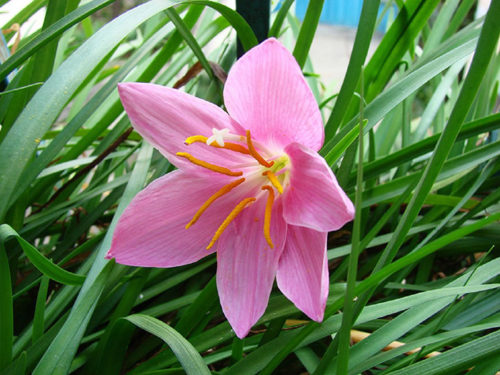
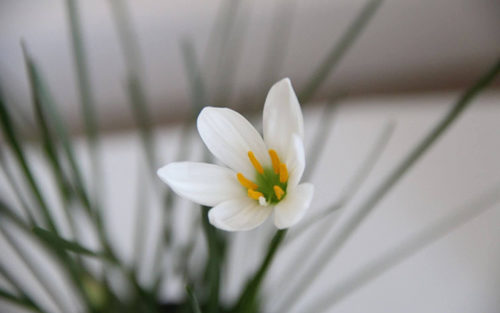
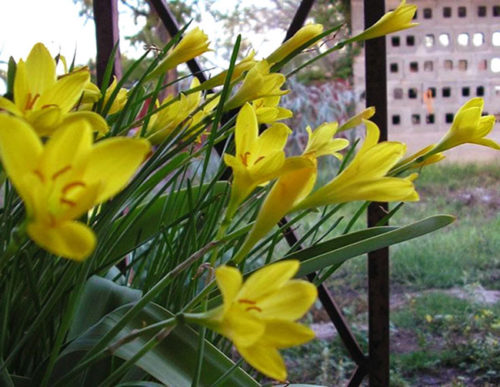
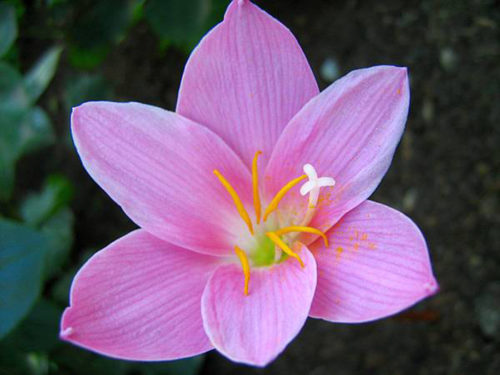
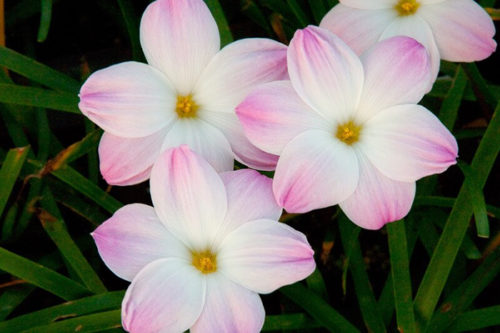
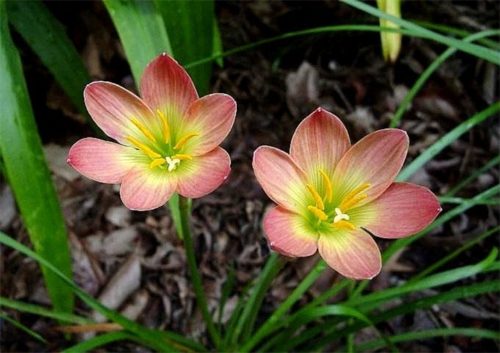

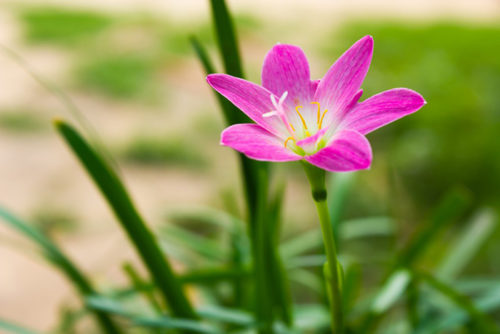
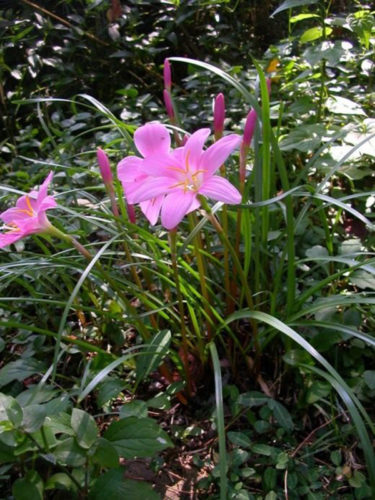
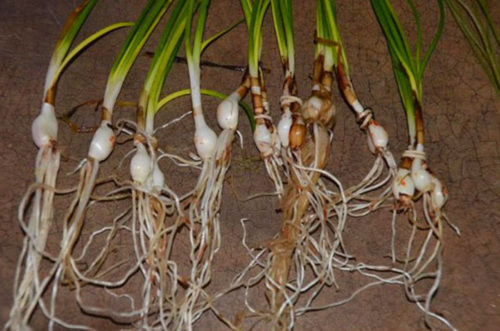
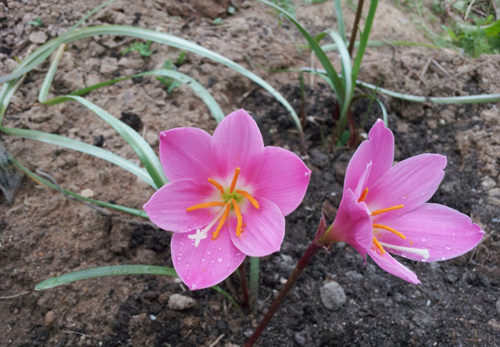
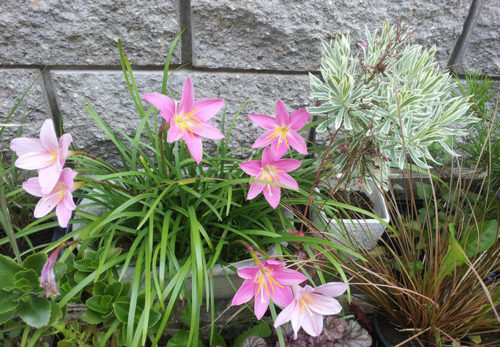
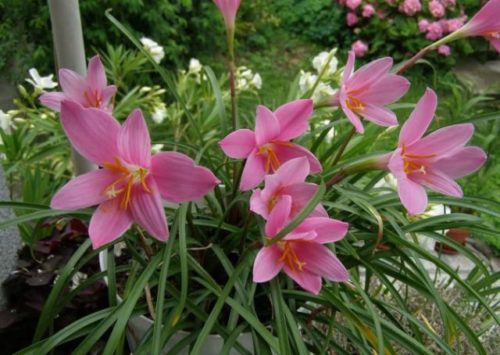













 Start a discussion ...
Start a discussion ...